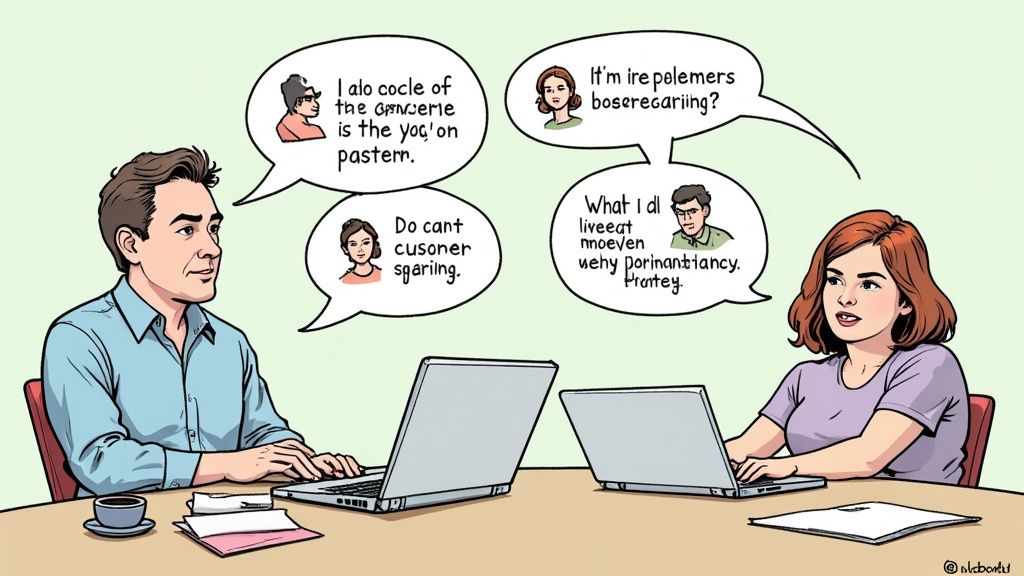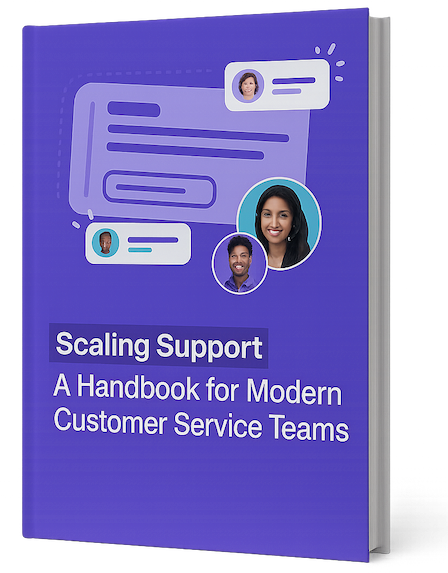A well-designed measurement strategy forms the foundation of successful customer service. By tracking the right metrics, you can gain clear insights into what works and what needs improvement. The key is moving beyond basic number tracking to using data that drives real improvements in how you serve customers.
Identifying Your Core Customer Service KPIs
Start by selecting KPIs that directly connect to your business goals. If retaining customers is your priority, focus on metrics like Customer Churn Rate and Net Promoter Score. For teams aiming to boost efficiency, First Contact Resolution (FCR) and Average Resolution Time provide essential data points.
These metrics work together to show different aspects of service quality. A high Customer Satisfaction Score points to happy customers and better retention, while low FCR numbers may reveal gaps in training or processes. By choosing complementary KPIs, you’ll get a complete view of how well your team serves customers.
Crafting a Multi-Faceted Measurement Approach
Single metrics tell only part of the story – the real power comes from combining different measurements. Think of it like examining a complex object from multiple angles to understand its true shape and structure.
For example, measuring both CSAT and Customer Effort Score gives you richer insights. High scores in both areas show you’re delivering satisfying experiences without hassle. But if customers report high satisfaction alongside high effort, it may signal underlying problems with your service process that need fixing – even though people are generally happy with outcomes.
Implementing and Refining Your KPI Framework
After choosing your key metrics, focus on setting up reliable systems to collect and analyze the data. Establish regular reporting schedules and quality checks to ensure accuracy. This creates a foundation for identifying meaningful patterns over time.
Remember that customer expectations and needs change, so your measurement approach should evolve too. Review your KPIs regularly to confirm they still align with your goals and adjust when needed. This ongoing refinement helps you stay focused on what matters most – delivering excellent service that keeps customers coming back.
Mastering CSAT: Beyond Basic Satisfaction Scores
Getting real value from Customer Satisfaction Score (CSAT) requires going deeper than just tracking basic scores. Companies that get the most from CSAT look closely at their data to find specific areas where they can make meaningful improvements to their customer service. Understanding not just what customers think, but why they feel that way, is essential for turning feedback into action.
Designing Effective CSAT Surveys
Carefully designed surveys are the foundation of useful CSAT data. A good survey focuses on specific moments in the customer’s experience rather than asking broad questions. For instance, instead of “How satisfied are you with our service?”, try “How satisfied were you with the help you received during your recent product return?” This precise approach helps you spot exactly where things are working well or need improvement. Keep surveys brief and use clear language to encourage more customers to respond – the more responses you get, the more reliable your data will be.
Identifying Critical Satisfaction Drivers
After collecting CSAT data, look for patterns that show what really shapes customer satisfaction. Study how different aspects of your service connect to CSAT scores. You might discover that quick response times strongly predict higher satisfaction levels – this tells you where to focus your improvement efforts. But don’t look at CSAT in isolation. Compare it with other key metrics like Customer Effort Score (CES). Even when CSAT is high, a high CES could reveal that customers are working too hard to get what they need, pointing to underlying issues in your service processes. For more insights on tracking important metrics, check out: How to master other essential KPIs.
Turning Feedback Into Concrete Service Improvements
The real power of CSAT comes from using the feedback to make specific improvements. Start by creating clear plans based on what your data shows. If customers consistently mention long wait times as a problem, you might need to adjust staffing levels or add chat support for simple questions. Share these insights across your whole team to build a culture where everyone works to make things better for customers. This focus on service quality pays off – research shows that good service now influences buying decisions even more than low prices, making strong CSAT scores increasingly valuable for business growth.
Practical Examples of CSAT Success
Many companies have used CSAT insights to make real changes that improved their service and results. One software company found that their help articles were hard to find and use, which hurt their CSAT scores. By rebuilding their knowledge base with user-friendly navigation, they saw customer satisfaction rise and support tickets drop. Another company learned their service quality varied too much between different support channels. They fixed this by standardizing their processes and giving their team more thorough training, which led to more consistent service and happier customers. These examples show how using CSAT data to guide specific changes can create measurable improvements in both service quality and business performance.
Leveraging NPS to Create Brand Advocates

While CSAT helps measure satisfaction with specific interactions, Net Promoter Score (NPS) gives a broader view of customer loyalty and their likelihood to recommend your business. By tracking this key metric, you can better predict future behavior and identify customers who may become advocates for your brand. Understanding and acting on NPS insights is essential for growing your business.
Understanding the Power of NPS
The NPS system revolves around one key question: “On a scale of 0 to 10, how likely are you to recommend [your company] to a friend or colleague?” Based on their answers, customers fall into three categories:
- Promoters (9-10): Your biggest fans who actively recommend you to others and keep coming back for more. These customers drive referrals and repeat business.
- Passives (7-8): Satisfied customers who aren’t particularly enthusiastic. They could be swayed by competitors but represent potential growth opportunities.
- Detractors (0-6): Unhappy customers who may speak negatively about your brand. They need immediate attention to prevent damage to your reputation.
To calculate your NPS, subtract the percentage of Detractors from Promoters. For example, with 60% Promoters and 20% Detractors, your NPS would be 40. The final score ranges from -100 to +100.
Implementing an Effective NPS Program
Gathering NPS data is just the beginning. To make the most of this feedback, you need a structured approach:
- Regular Surveys: Consistent feedback collection shows how customer sentiment changes over time.
- Closed-Loop Feedback: Following up with respondents, especially Detractors, demonstrates that you value their input. Quick responses to concerns can help shift negative perceptions.
- Targeted Action Plans: Use feedback patterns to guide improvements. If multiple Detractors mention slow response times, focus on speeding up support. When Passives note missing features, add them to your development plans.
Turning Insights Into Action With Customer Service KPIs
NPS works best when combined with other metrics like CSAT, FCR, and CES to paint a complete picture. High NPS with strong CSAT shows excellent service delivery, while high NPS but low CSAT may reveal hidden issues beneath surface-level loyalty. Looking at these numbers together helps you better understand what your customers truly need.
Breaking down NPS data by customer segments – like demographics or purchase history – lets you fine-tune your approach for different groups. This focused strategy helps you move beyond generic fixes to create experiences that really connect with customers. For example, if you notice declining NPS among your highest-value customers, you can quickly step in with specific improvements for that group.
By building a thorough NPS program and connecting it with other key metrics, you can turn happy customers into true champions for your brand, leading to lasting business growth. This active approach helps you catch and fix issues early while steadily improving service quality to build stronger customer relationships.
First Contact Resolution: The Path to Service Excellence
First Contact Resolution (FCR) is a key performance metric in customer service that shows the percentage of support issues solved during the initial interaction. A high FCR means happy customers and lower operating costs since support teams can resolve issues efficiently without repeat contacts. It’s a clear indicator of how well your service team delivers solutions right from the first conversation. For example, when agents resolve issues on the first try, they have more time to help other customers, improving productivity across the team.
Understanding the Importance of FCR
Your FCR score offers a window into your customer service health. If you notice customers keep reaching out about the same problems, it often points to deeper issues – perhaps your agents need more training, your help documentation needs work, or there could be product problems to address. When customers have to contact support multiple times, they get frustrated and may take their business elsewhere. This makes FCR critical for keeping customers satisfied and loyal.
Strategies for Improving First Contact Resolution
Getting better at FCR requires focusing on three key areas: empowering your support team, building strong resources, and using the right tools.
- Agent Empowerment: Give your agents what they need to succeed. This means thorough product training, clear service guidelines, and easy access to help resources so they can handle any customer question with confidence. No customer wants to feel their agent is scrambling to find basic information.
- Knowledge Base Optimization: A well-organized help center serves both customers and agents. Keep content up-to-date, easy to search, and focused on common customer questions. Include clear visuals like screenshots and videos to explain complex topics. This helps customers find answers themselves and lets agents quickly locate solutions during chats.
- Smart Tools and Systems: Choose support platforms with features that speed up resolution. Route questions to the right agent based on their skills. Set up automated responses for basic issues so agents can focus on complex problems. The right technology helps your team work smarter, not harder.
Real-World Examples and Pitfalls to Avoid
Many companies have found success improving FCR through focused effort. One team boosted their FCR by 20% after overhauling their knowledge base and agent training program. Another saw a 15% jump by using chatbots to handle routine questions. However, be careful not to sacrifice quality for speed. Rushing to close tickets without fully solving issues will only frustrate customers more. The key is finding the right balance – give agents time to listen and solve root problems while still working efficiently. Provide clear processes and resources so your team can consistently deliver great service on first contact. Over time, this leads to happier customers, more productive agents, and a stronger business.
Using Predictive Analytics to Prevent Customer Churn

Smart businesses are moving away from simply reacting to customer problems. Instead, they use customer service metrics as early warning signals to spot and address issues before customers leave. This shift from reactive to proactive support focuses on preventing customer losses rather than just responding after they occur. The key to making this work is analyzing customer data to predict potential problems.
Identifying At-Risk Customers Through Interaction Patterns
By looking at how customers interact with your business over time, you can spot warning signs that someone might be unhappy. For example, if a customer who rarely needed help suddenly starts filing multiple support tickets with frustrated language, or if their satisfaction scores begin dropping, these could signal they’re considering leaving. Traditional support approaches often miss these subtle changes, but analyzing these patterns helps catch problems early. Consider a long-time customer who begins contacting support more frequently with increasingly negative feedback – this shift in behavior likely points to deeper issues that need addressing.
Developing Effective Intervention Programs
Once you identify customers who might leave, the next step is taking action to keep them. This could mean having a customer success manager reach out personally, offering extra help proactively, or providing special perks to show you value their business. For example, if data shows a customer is struggling with a particular feature, you might offer them a free training session. Understanding exactly why customers become unhappy through data analysis helps create more focused and successful retention programs.
Measuring the Impact of Retention Efforts
Tracking whether your retention efforts actually work is just as important as identifying at-risk customers. By monitoring metrics like customer churn rate, lifetime value, and retention after implementing programs, you can see what’s working and what isn’t. This creates a feedback loop that helps continuously improve both your predictions and your retention strategies. Looking at how different approaches affect customer behavior and key metrics shows which efforts give you the best results.
Combining Multiple Metrics for Predictive Accuracy
The most effective approach uses multiple metrics together rather than relying on just one. By looking at satisfaction scores, Net Promoter Score, ease-of-use ratings, and how often customers interact with you, you get a more complete picture of customer health. For instance, even if someone gave you high marks for being likely to recommend your company, a sudden drop in how much they use your product could still mean they’re at risk of leaving. Using multiple data points together helps spot patterns you might miss otherwise, leading to better predictions about who needs attention. This comprehensive view allows businesses to address the real reasons customers leave and improve their overall retention.
Balancing Technology and Human Connection in Service Delivery

Customer service has become more complex with the rise of automation and AI. While these tools offer great efficiency gains, maintaining genuine human connections remains essential for building lasting customer relationships. The key is finding the right mix of automated and personal service delivery, guided by customer service metrics that help track both aspects.
Measuring the Effectiveness of Automated Service
Smart automation can handle routine inquiries effectively, allowing support teams to focus on complex customer needs. But measuring automated service requires specific metrics. The Self-Service Resolution Rate shows how often customers successfully solve issues using chatbots or help centers without human assistance. Average Handling Time for Automated Responses indicates how quickly automated systems resolve customer questions. These metrics help teams pinpoint where automated solutions need improvement to better serve customers.
Evaluating Human-Delivered Service in a Tech-Driven World
Personal interaction is still irreplaceable, especially for nuanced situations requiring empathy and customized support. The human side of service needs its own measurement approach focused on interaction quality. Customer Satisfaction Score (CSAT) and Net Promoter Score (NPS) give insights into overall customer happiness and loyalty. First Contact Resolution (FCR) for issues handled by agents shows their ability to fully resolve customer problems in one interaction.
Optimizing the Service Mix: Finding the Right Balance
Success comes from knowing which issues work best for automation versus human support. This requires analyzing customer journeys to identify where each approach adds the most value. Basic tasks like order tracking often work well automated, while technical problems and complaints need a personal touch. Getting this balance right improves both efficiency and relationship-building. For example, companies that effectively combine automation and human service often see higher CSAT scores along with reduced costs.
Practical Examples of Balanced Service Delivery
Many businesses demonstrate how this balanced approach works in practice. A telecom provider uses AI chatbots for billing questions while keeping human agents focused on technical support. This improved their FCR for complex issues and boosted customer satisfaction. An online retailer automates order notifications but maintains personal service for product advice and returns handling. Their balanced strategy led to better conversion rates and stronger customer relationships. These examples show how tracking the right metrics for both automated and human service helps companies optimize their approach.
Ready to streamline your customer service and boost customer satisfaction? SupportMan integrates Intercom ratings directly into Slack, giving you instant feedback and enabling your team to respond effectively. Start your free trial today – no credit card required! https://supportman.io


